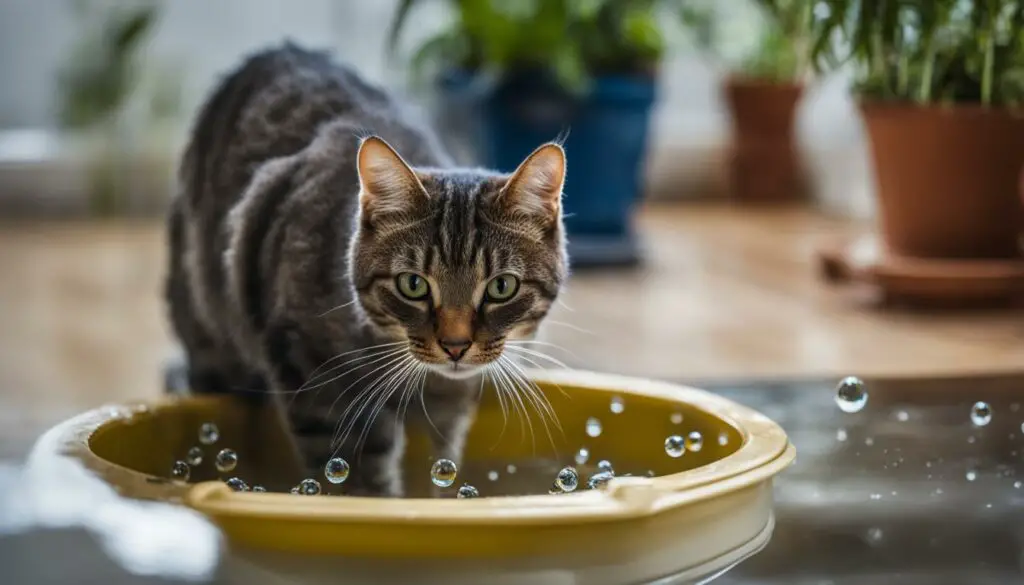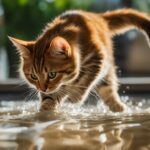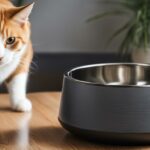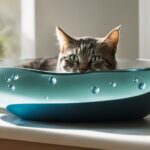As a cat owner, I’ve often wondered why my feline companion tries to bury her water. It’s a curious behavior that many cat owners have observed, and it raises questions about why our cats engage in this seemingly peculiar act. After doing some research and consulting with experts, I’ve discovered that there are several reasons why cats exhibit this behavior. Understanding these reasons can help us better understand and care for our beloved pets.
Key Takeaways:
- Cats try to bury their water due to territorial instincts, scent marking, hunting behavior, and even whisker discomfort.
- Some cats paw around their water dish before drinking, which can be an instinctive behavior or a way to entertain themselves.
- Water can be entertaining for cats, especially when it’s reflective and creates ripples that kittens find captivating.
- Each cat has unique drinking habits, with some preferring moving water or engaging in pawing rituals.
- Whisker discomfort and compulsive behavior can also contribute to pawing around the water dish.
Why Do Cats Paw Around Their Water Dish?
When it comes to cats, their behaviors can often leave us puzzled. One particular behavior that cat owners may observe is their tendency to paw around their water dish before drinking. This seemingly odd behavior can have several explanations.
One reason behind this behavior is instinct. Cats are natural predators and have an instinct to claim their territory. By pawing around their water dish, they may be marking it as their own, signaling to other cats that this is their space.
Another possible reason is that cats find the reflective nature of water intriguing. They may paw at the water to create ripples or to interact with their own reflection, turning it into a form of entertainment. This behavior is more commonly observed in kittens who are still exploring their environment and experimenting with different stimuli.
| Reasons for Cats Pawing Around Their Water Dish | Explanation |
|---|---|
| Instinct | Cats mark their territory by pawing around their water dish. |
| Entertainment | Cats enjoy the reflective nature of water and paw at it for fun. |
| Vision Difficulties | Cats with vision problems may paw at the water to better see it. |
| Whisker Discomfort | Narrow water bowls can cause whisker discomfort, leading cats to paw at the water instead of sticking their whiskers in. |
Quote: “Pawing around the water dish can also be a sign of curiosity or a cat’s natural inclination to explore and interact with objects they find.
In some cases, cats may paw at their water dish due to vision difficulties. They may be trying to get a better view of the water or to gauge its depth. If you notice your cat frequently pawing at the water, it might be worth getting their vision checked by a veterinarian.
Whisker discomfort can also play a role in this behavior. Cats have sensitive whiskers, and if their water dish is too narrow, it can cause discomfort known as whisker fatigue. Pawing at the water allows them to scoop it up with their paws instead of putting their whiskers in the bowl.
In conclusion, there are various reasons why cats paw around their water dish. It can be a way for them to mark their territory, find entertainment, compensate for vision difficulties, or alleviate whisker discomfort. Understanding these reasons can help cat owners better comprehend their furry companions and provide suitable solutions to ensure their well-being.
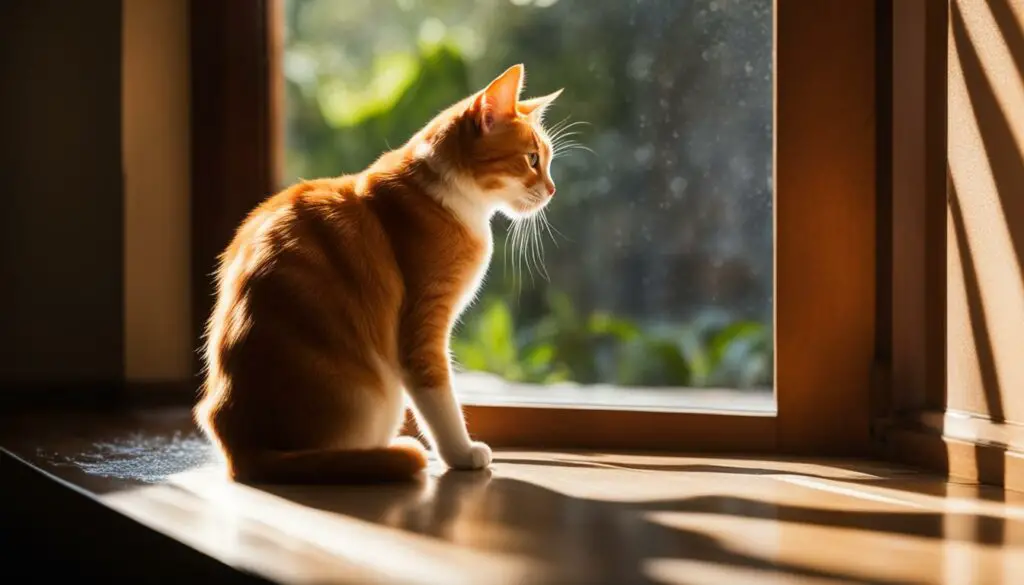
Water Is Entertaining for Cats
Water can be surprisingly entertaining for our feline friends. Many cats are naturally drawn to shiny and reflective objects, and water falls into this category. Whether it’s a kitchen faucet, a dripping tap, or a glass bowl filled with water, cats often find joy in interacting with the element.
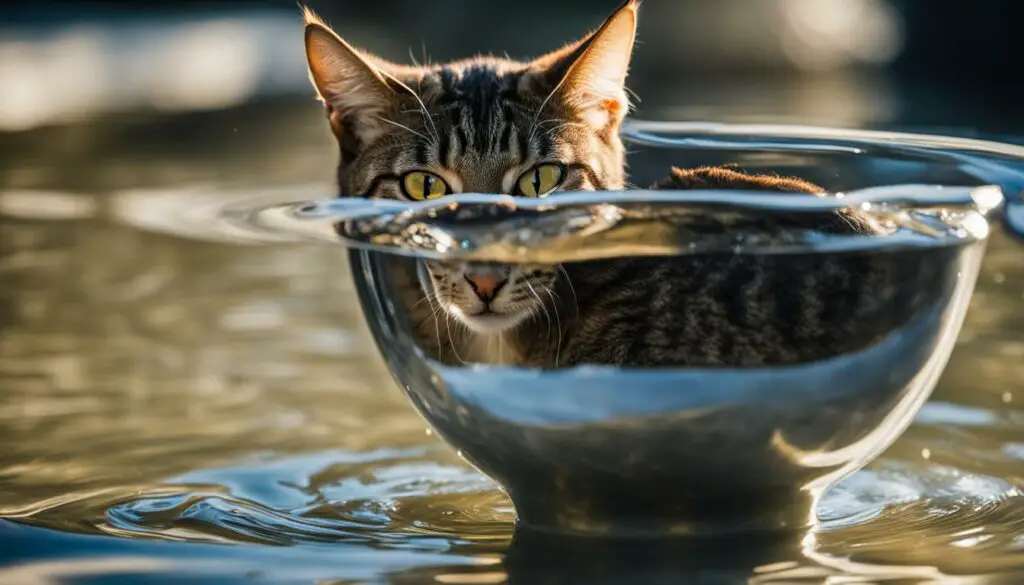
Young kittens, in particular, may be fascinated by the sight of water in a bowl. They may paw at it, creating ripples and splashes, transforming the still water into a dynamic playground. This interactive experience can provide mental and physical stimulation for kittens, allowing them to engage their natural hunting instincts in a safe and controlled environment.
When using a stainless steel or glass water bowl, the reflective properties of the material can make the water even more intriguing for cats. The way the light dances on the surface can captivate their attention and entice them to interact with it.
Water Play Tips for Cat Owners:
- Provide a separate play area with shallow water for playful interaction.
- Experiment with different water sources, such as a small fountain or dripping tap, to keep your cat entertained.
- Supervise water play sessions to ensure safety and prevent excessive splashing.
- Consider using interactive toys, such as floating balls or water dispensers, to add an extra element of fun to your cat’s water play.
By understanding and embracing the entertaining nature of water for cats, we can provide them with enriching experiences that cater to their natural instincts and contribute to their overall well-being.
Drinking Habits of Cats
Understanding the drinking habits of cats can provide valuable insights into their behavior and preferences. While some cats are content with simply drinking from a water bowl, others may exhibit more unique habits when it comes to staying hydrated. Let’s explore different drinking behaviors that cats may display:
Table: Common Drinking Habits of Cats
| Drinking Habit | Description |
|---|---|
| Moving Water Preference | Some cats prefer drinking from a source of moving water, such as a faucet or a pet fountain. This behavior may stem from their natural instinct to seek out fresh water in the wild. |
| Pawing at Water | Certain cats may engage in pawing behavior around their water bowl before drinking. This action is thought to be a way for cats to test the depth of the water or display pleasure. |
| Picky Drinkers | There are cats that can be considered picky drinkers, turning their nose up at tap water or water that has been sitting out for too long. They may prefer a specific type of water or even certain containers. |
| Preference for Wide Bowls | Some cats avoid drinking from narrow or deep bowls due to the discomfort it can cause their sensitive whiskers. They may show a preference for wide and shallow bowls that allow them to drink comfortably. |
| Drinking Rituals | A few cats have established drinking rituals, which can include pawing at the water, taking a few sips, and repeating the process. These rituals may serve as a way for cats to establish a sense of control and routine. |
By observing and accommodating these drinking habits, cat owners can ensure that their feline companions have access to water in a way that suits their preferences. Providing different water sources, such as pet fountains or shallow bowls, can cater to cats with specific habits or sensitivities. It’s essential to keep in mind that each cat is an individual with unique preferences, and by understanding their drinking habits, we can help promote their overall well-being.
Whisker Discomfort and Pawing
One possible reason why cats paw around their water dish is whisker discomfort. Cats have highly sensitive whiskers that help them navigate their surroundings. If a cat’s water dish is too narrow or deep, it can cause discomfort known as whisker fatigue. This discomfort may be the reason why cats engage in pawing behavior around their water bowl. By pawing at the water, they are trying to scoop it up using their paws instead of sticking their sensitive whiskers into the narrow bowl.
Understanding and addressing whisker discomfort can help alleviate this behavior. Providing a wider and shallower water dish can help prevent whisker fatigue and make drinking more comfortable for cats. Additionally, using wide or shallow bowls made specifically for cats can also help reduce pawing behavior. It’s important to ensure that the water dish is cleaned regularly to maintain cleanliness and freshness, as this can also contribute to a cat’s preference for pawing behavior.
Table: Different Types of Water Bowls and Their Impact on Whisker Discomfort
| Water Bowl Type | Impact on Whisker Discomfort |
|---|---|
| Narrow and Deep Bowl | Can cause whisker fatigue and discomfort, leading to pawing behavior. |
| Wide and Shallow Bowl | Reduces whisker fatigue and discomfort, minimizing pawing behavior. |
| Specially Designed Cat Bowl | Optimizes comfort for cats with sensitive whiskers, reducing pawing behavior. |
It’s important to note that whisker discomfort and pawing behavior may also be influenced by factors such as a cat’s individual preferences and habits. Observing and understanding your cat’s behavior can help determine the most suitable water bowl option for them. Creating a comfortable and stress-free drinking environment can promote healthier drinking habits and reduce undesirable behaviors like excessive pawing.
In conclusion, whisker discomfort can be a significant factor behind a cat’s pawing behavior around their water dish. Understanding the impact of whisker fatigue and providing appropriate water bowl options can help alleviate this behavior and ensure your feline companion has a comfortable and enjoyable drinking experience.
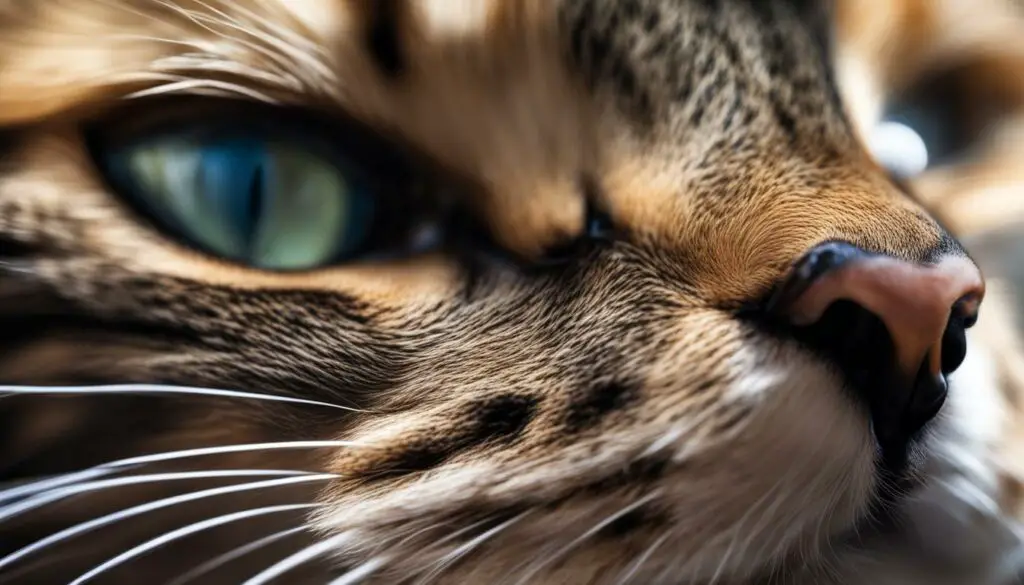
Compulsive Behavior and Pawing: Understanding Your Cat’s Actions
If you’ve noticed your cat displaying compulsive behavior, such as excessive pawing around their water dish, it’s important to understand the underlying reasons behind these actions. Cats can exhibit compulsive behavior as a response to stress or changes in their environment. Pawing around the water dish may serve as a coping mechanism for your cat to alleviate anxiety or express their displeasure with the water.
Compulsive behavior in cats can be triggered by various factors, such as boredom, lack of mental stimulation, or even previous traumatic experiences. If you suspect that your cat’s pawing behavior is due to compulsive tendencies, it’s important to consult with a veterinarian or animal behaviorist for proper evaluation and guidance.
Creating a stimulating environment for your cat with interactive toys, scratching posts, and designated play areas can help redirect their energy and alleviate compulsive behaviors. Additionally, providing your cat with a calm and predictable routine, regular exercise, and positive reinforcement can contribute to their overall well-being and reduce stress-related compulsive behaviors.
Table: Common Causes of Compulsive Behavior in Cats
| Cause | Description |
|---|---|
| Stress | Changes in the household, new pets, or other sources of stress can trigger compulsive behaviors. |
| Boredom | Lack of mental and physical stimulation can lead to the development of compulsive behaviors. |
| Traumatic Experiences | Past traumas or negative experiences can contribute to the development of compulsive behaviors. |
| Medical Conditions | Sometimes, compulsive behaviors can be a symptom of an underlying medical condition. It’s important to rule out any potential health issues through a thorough examination by a veterinarian. |
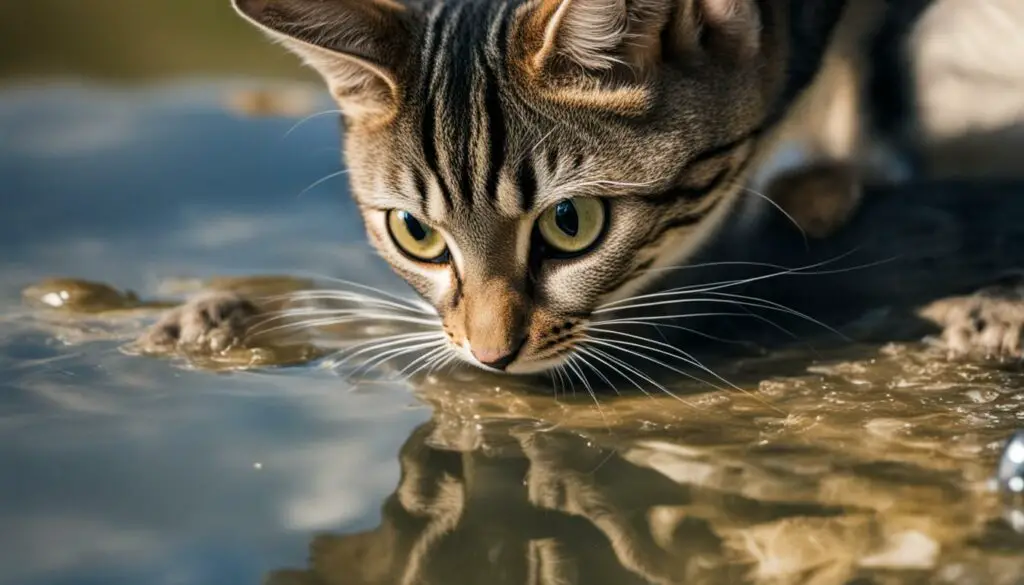
Understanding your cat’s compulsive behavior and providing appropriate environmental and behavioral enrichment can help manage and reduce these actions. By addressing the underlying causes, you can improve your cat’s quality of life and strengthen the bond between you and your feline companion.
Territorial Instinct and Water Dish
Cats have a strong territorial instinct and may use their paws to claim their ownership over objects, including their water dish. Scratching or pawing around the water dish can be a way for cats to mark their territory and communicate to other cats that the area is off-limits. This behavior is more prevalent in multi-cat households or if the water dish is located near a window where outdoor cats mark their territory.
Cats are known for their independence and need to establish their own territory. By scratching or pawing around their water dish, they are leaving their scent and marking it as their own. This territorial behavior is a natural instinct that allows cats to feel secure in their environment and assert their dominance. It is important for cat owners to understand and respect this behavior as it is a fundamental part of a cat’s nature.
To minimize territorial conflicts, it is recommended to provide multiple water sources in multi-cat households. Having separate water dishes in different locations can help prevent competition over resources and reduce the need for territorial marking. Additionally, ensuring that each cat has their own food and water bowls can also alleviate any potential conflicts and promote a harmonious living environment.
Table: Tips for Managing Territorial Instinct
| Tips | Description |
|---|---|
| Provide Multiple Water Sources | Place water dishes in different areas to prevent competition. |
| Separate Food and Water Bowls | Ensure each cat has their own designated bowls for food and water. |
| Keep Water Dish Clean | Regularly clean and refill the water dish to maintain freshness and hygiene. |
| Create Distinct Territories | Offer each cat their own space and resources to reduce conflicts. |
| Provide Environmental Enrichment | Offer toys, scratching posts, and perches to stimulate their minds and bodies. |
Understanding and accommodating a cat’s territorial instincts is crucial for their overall well-being. By providing a suitable environment and respecting their need for personal space, cat owners can help foster a harmonious living environment for their feline companions.
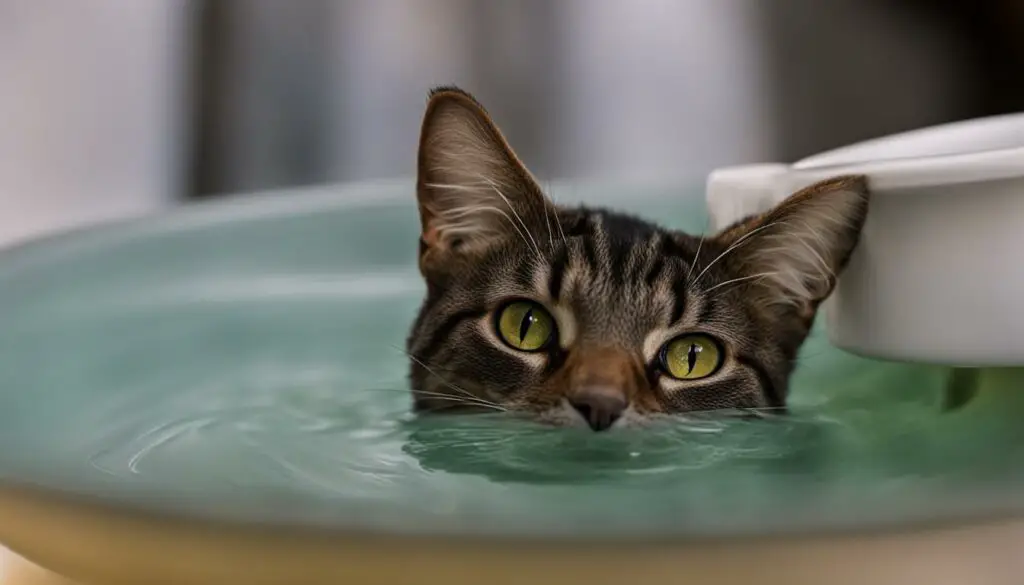
Burying Behavior and Water
When it comes to their water, some cats display a curious behavior of trying to bury it. This burying behavior can be puzzling to cat owners, but it actually has a few possible explanations. One reason for this behavior is that cats may perceive their water as dirty or undesirable, prompting them to try and bury it. Burying the water may be their way of expressing discontent or attempting to cover up any unpleasant odors associated with the water.
Another possible reason for this burying behavior is the cat’s instinctual desire to hide or protect their resources. In the wild, cats may bury leftover food or prey to keep it safe from potential predators. This natural instinct can extend to domesticated cats, leading them to exhibit similar burying behavior with their water. By attempting to bury their water, cats may be trying to hide it from perceived threats or simply engaging in a form of resource protection.
In some cases, the burying behavior may also be a sign of a cat’s preference for a different water source. If a cat consistently buries its water, it could indicate that they are not satisfied with the current water supply and prefer an alternative. This could be due to factors such as taste, temperature, or the presence of contaminants. In such cases, providing a new water source or ensuring regular water changes may help address the burying behavior.
Understanding the reasons behind a cat’s burying behavior can help cat owners better meet their feline companions’ needs. By providing clean and fresh water, ensuring access to alternative water sources if needed, and addressing any potential issues with the current water supply, cat owners can create a more satisfying and comfortable drinking experience for their beloved pets.
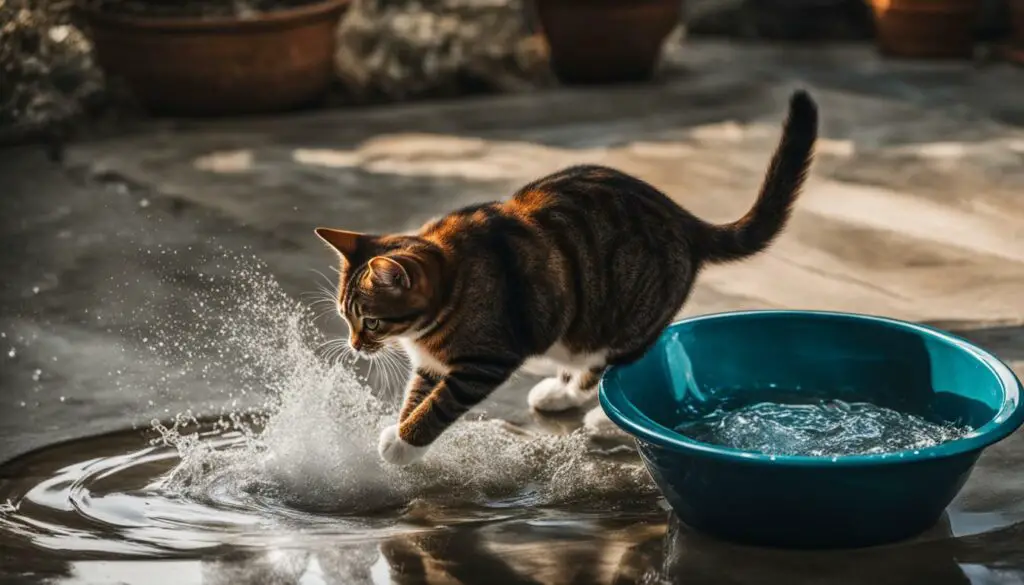
Table: Possible Reasons for Cat Burying Behavior with Water
| Reason | Description |
|---|---|
| Perceived dirtiness or undesirability | Cats may try to bury their water if they find it unclean or unpleasant. |
| Instinctual resource protection | Cats have an instinct to hide or protect their resources, which can extend to their water. |
| Preference for alternative water source | If a cat consistently buries its water, it may indicate a preference for a different water supply. |
Curiosity and Scratching Behavior
Cats are naturally curious creatures, and their curiosity often leads them to explore and interact with their environment. This includes engaging in scratching behavior around their water bowl. Cats may scratch the floor or walls near their water dish out of pure curiosity, as they are intrigued by the objects they encounter. This behavior allows them to investigate their surroundings and satisfy their innate desire for exploration.
Scratching behavior around the water dish may also be a way for cats to mark their territory or communicate their presence to other cats in the household. By leaving visible scratch marks, cats are essentially claiming the area as their own and asserting their ownership over the water bowl.
“Just because I scratch around my water dish, doesn’t mean I’m being destructive. I’m just expressing my natural instincts and marking my territory,” says Dr. Sarah Thompson, a feline behavior specialist.
Additionally, scratching behavior can serve as a form of exercise and stress relief for cats. Cats have scent glands in their paws, and scratching the floor or walls around their water bowl allows them to release pheromones and leave their scent behind. This helps them feel more secure in their environment and can reduce anxiety or tension that they may be experiencing.
As a cat owner, it’s important to provide appropriate outlets for your cat’s scratching behavior. You can offer scratching posts or boards near the water bowl area, providing a designated space for your cat to engage in this natural behavior. By understanding and accommodating your cat’s curiosity and scratching instincts, you can help create a harmonious and enriched environment for your feline friend.
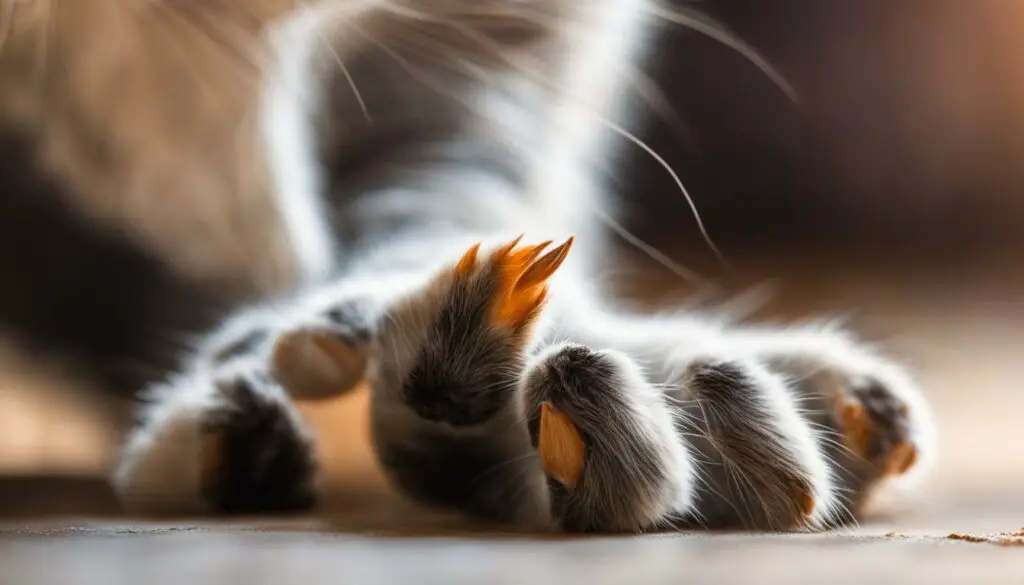
Scratching Behavior Tips:
- Provide a scratching post or board near the water bowl area to redirect your cat’s scratching behavior.
- Regularly trim your cat’s nails to prevent damage to furniture or other surfaces.
- Use positive reinforcement and rewards to encourage your cat to use the designated scratching area.
- Ensure the scratching area is stable and secure to prevent accidents or injuries.
Maternal Instincts and Scratching Behavior
Cats are known for their strong maternal instincts, and this can often be observed in their behavior around their water bowl. Scratching behavior around the water bowl can be attributed to a cat’s natural instinct to protect and hide prey or food from potential threats. In the wild, mother cats would bury prey to keep it safe and concealed. This behavior can carry over to domestic cats, where they may exhibit scratching behavior as a way to hide their water from perceived threats.
The maternal instinct to hide prey or food in the water bowl is a form of teaching behavior. By scratching around the water bowl, cats may be trying to demonstrate hunting behaviors and pass on their hunting knowledge. This behavior can be seen as an attempt to involve their owners in the hunting process and share their experience.
As cat owners, it’s important to understand and appreciate this scratching behavior as a manifestation of maternal instincts. Providing a clean and separate water source for the cat can help address this behavior effectively. Additionally, ensuring a stimulating environment with toys and interactive play can help satisfy a cat’s natural hunting instincts and provide mental and physical stimulation.

Hiding Prey and Water Bowl
One possible reason why cats display scratching behavior around their water bowl is their natural instinct to hide prey. In the wild, cats often catch their prey but may choose not to consume it immediately. By placing the captured prey in their water bowl, cats can keep it safe and concealed from potential threats or competitors. This behavior reflects their innate hunting instincts and serves as a way for them to simulate the hunting process before consuming their food.
This hiding behavior can also be attributed to a cat’s desire to protect its valuable resources. By scratching around the water bowl, cats may be trying to create a barrier or cover to deter other animals from accessing their water source. This territorial behavior is especially common in multi-cat households or when outdoor cats mark their territory near windows or doors.
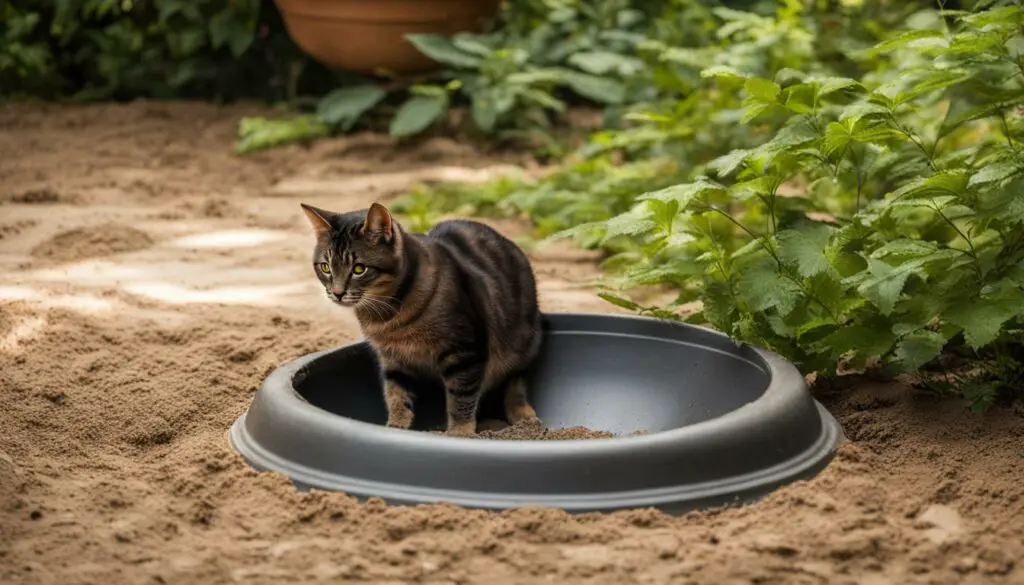
To further understand this behavior, let’s take a look at a table that summarizes the key factors and motivations behind a cat’s scratching behavior around the water bowl:
| Motivations | Description |
|---|---|
| Hunting Instinct | Cats hide prey in their water bowl to mimic the hunting process and keep their food safe. |
| Territorial Marking | Scratching around the water bowl is a cat’s way of marking its territory and protecting valuable resources. |
By understanding these underlying motivations, cat owners can better appreciate and accommodate their feline companions’ natural behaviors around their water bowls. It is important to provide a separate and clean water source for each cat to avoid potential conflicts and ensure that all cats have access to fresh water throughout the day.
Teaching Behavior and Water Bowl
When it comes to cats, their behavior can often surprise and intrigue us. One interesting behavior that some cats exhibit is using their water bowl as a tool for teaching. This behavior is especially common in mothers raising their kittens. Cats may place objects in their water bowl as a way of demonstrating hunting behaviors and passing on their hunting knowledge.
This teaching behavior can be seen as an attempt to involve their owners in the hunting process and share their experiences. By placing toys, small prey-like objects, or even cat treats in the water bowl, cats are not only engaging in play but also providing a valuable lesson for their owners to observe. It’s their way of saying, “This is how you hunt, and this is how you survive.”
As owners, we can appreciate this teaching behavior and use it as an opportunity to bond with our cats and learn from their natural instincts. By observing and understanding their actions, we can gain insight into their hunting behaviors, which are deeply ingrained in their feline nature. This behavior also underscores the importance of providing opportunities for mental and physical stimulation for our cats, such as interactive toys or puzzle feeders, to simulate the hunting experience in a safe and controlled environment.
Table: Objects Used for Teaching Behavior
| Object | Meaning |
|---|---|
| Toy mouse | Simulates prey |
| Treat | Rewards for successful “hunt” |
| Feather wand | Encourages pouncing and chasing |
| Small ball | Promotes batting and swatting |
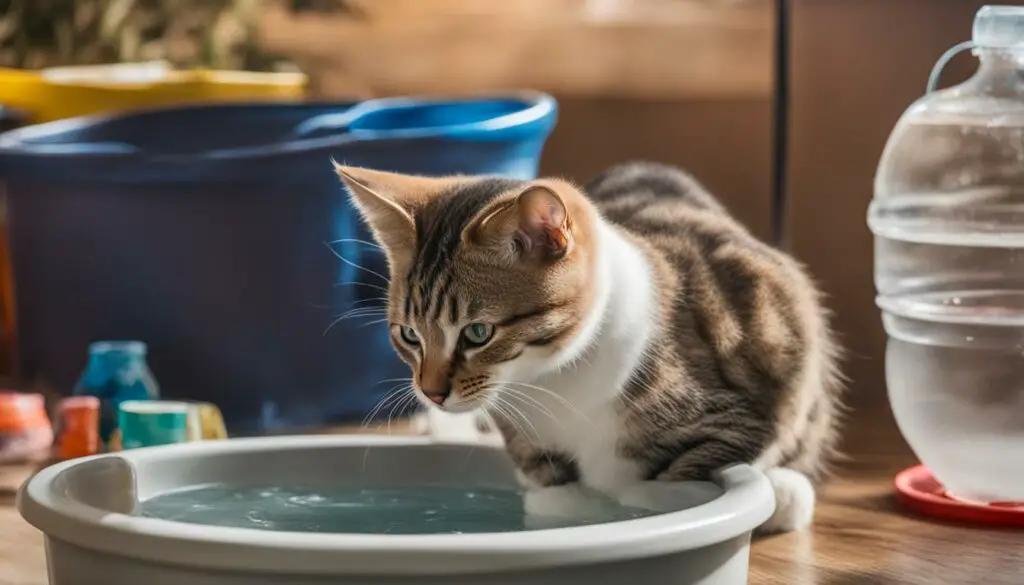
In conclusion, the teaching behavior exhibited by cats using their water bowl provides us with a window into their hunting instincts and offers an opportunity for us to learn from their natural behaviors. By engaging with our cats and observing their actions, we can better understand and appreciate their feline nature. So next time you see your cat placing objects in their water bowl, take a moment to observe and participate in their teaching behavior, and embrace the valuable lessons they share.
Showing Gratitude and Pawing Behavior
When cats paw around their water bowl, it can sometimes be a sign of gratitude and appreciation towards their owners. This behavior serves as a way for them to communicate their thanks for the care and love they receive. As cat owners, it’s important to understand and acknowledge these gestures of affection from our feline companions.
Just like humans, cats have their own unique ways of showing gratitude. While they may not be able to express it in words, their actions speak volumes. By pawing at their water bowl, cats are trying to convey their appreciation for the reliable source of fresh water and the love they receive from their owners. It’s their way of saying, “Thank you for taking care of me.”
As cat owners, it’s crucial to recognize and reciprocate these gestures of gratitude. By providing a clean and separate water source for our cats, we can ensure that they always have access to fresh water. Additionally, spending quality time with our cats, engaging in play, and providing them with a stimulating environment can further strengthen the bond between us and show our cats that we appreciate their presence in our lives.
| Ways to Show Gratitude to Your Cat |
|---|
| 1. Provide clean and fresh water daily. |
| 2. Spend quality time playing and bonding with your cat. |
| 3. Offer nutritious meals and treats. |
| 4. Create a stimulating environment with toys and scratching posts. |
| 5. Give gentle petting and affectionate strokes. |
By reciprocating our cats’ gestures of gratitude, we can strengthen the bond between us and create a mutually fulfilling relationship. Taking the time to understand and appreciate our cats’ behaviors, such as pawing around their water bowl, allows us to better connect with them and provide for their needs.
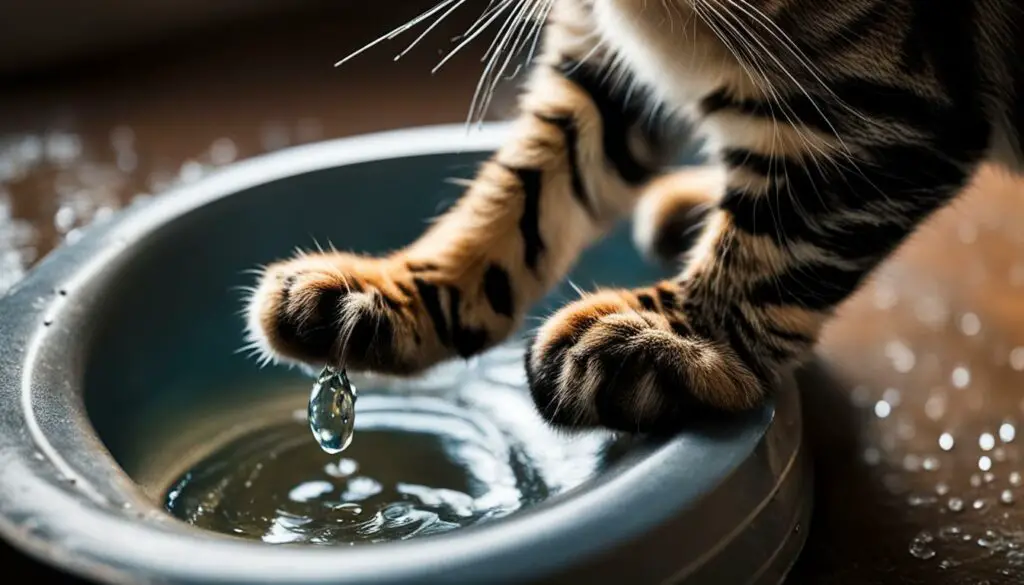
Understanding Pawing Behavior in Cats
Cats exhibit a variety of behaviors, and pawing is just one way they express themselves. Pawing around their water bowl can be a sign of gratitude and appreciation, as well as an instinctual behavior rooted in their hunting and territorial nature. By observing and responding to these behaviors, we can enhance our relationship with our feline friends and create a harmonious living environment.
Fun and Entertainment
Cats are known for their playful nature and their love for engaging in activities that bring them joy and entertainment. When it comes to their water bowl, some cats may exhibit scratching behavior as a form of fun and amusement. They may paw at the water or bat around objects placed near the bowl, creating a playful environment for themselves. This behavior can provide both mental and physical stimulation for cats, contributing to their overall well-being.
One possible reason for this behavior is that cats enjoy the tactile sensation of interacting with water. The movement of water and the ripples they create can be intriguing and captivating for cats, encouraging them to engage in playful behavior around their water bowl. Additionally, objects placed in or near the water may serve as toys for cats, further enhancing their entertainment. It’s important for cat owners to ensure that the water is clean and safe for their feline companions to play with, providing them with a source of fun and enjoyment.
“Cats are natural hunters and explorers, and engaging in playful activities around their water bowl allows them to satisfy their innate instincts,” says feline behavior expert Dr. Emily Hunter. “Providing a stimulating environment with interactive toys and engaging with your cat during playtime can help enhance the fun and entertainment they experience.”
Creating a cat-friendly environment that includes various interactive toys and objects can encourage cats to engage in playful behavior around their water bowl. This can involve incorporating puzzle toys, interactive feeding systems, or even setting up a small water fountain for cats to play with. By promoting a fun and stimulating environment, cat owners can ensure that their feline companions have access to enriching activities that satisfy their natural instincts and provide them with endless entertainment.
| Benefits of Fun and Entertainment | Examples |
|---|---|
| Physical exercise | Chasing and pawing at objects |
| Mental stimulation | Interactive puzzle toys |
| Stress reduction | Engaging in playful activities |
| Bonding with owners | Participating in interactive play sessions |
In conclusion, fun and entertainment play an important role in a cat’s life. Engaging in scratching behavior around their water bowl allows cats to enjoy playful activities while satisfying their natural instincts. By providing a stimulating environment and incorporating interactive toys, cat owners can ensure that their feline companions have access to enriching experiences that contribute to their overall well-being. So go ahead, let your cat have some fun and enjoy watching them frolic around their water bowl!
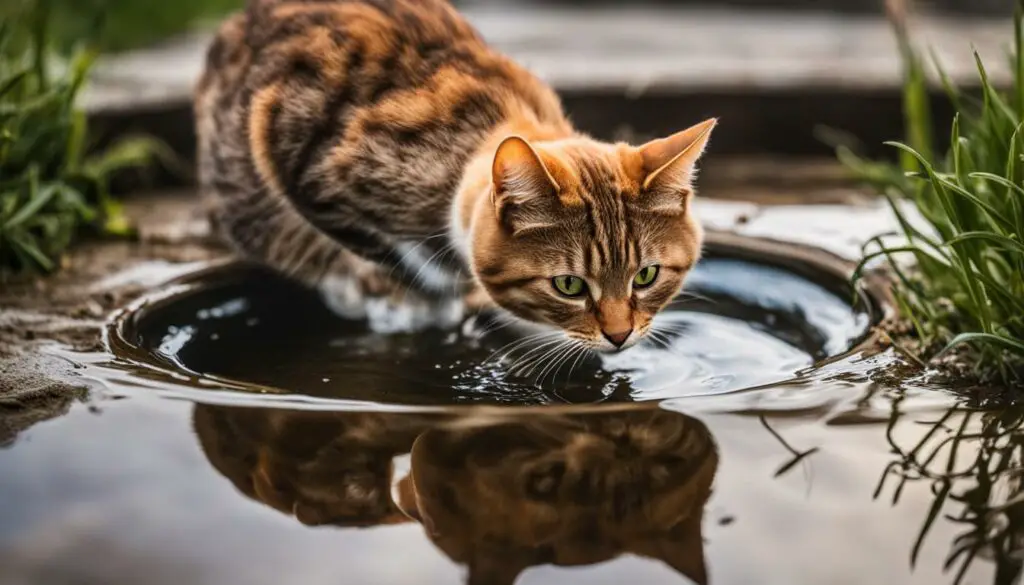
Conclusion
Understanding our feline companions’ behaviors is crucial in providing them with the care and attention they deserve. Scratching behavior around the water bowl is a common feline behavior, and it serves various purposes. Cats may engage in this behavior due to territorial instincts, scent marking, curiosity, or even whisker discomfort.
By recognizing these behaviors as natural instincts, we can better address and manage them. Providing a clean and separate water source, understanding their preferences, and ensuring a stimulating environment can help alleviate any concerns associated with this behavior. Additionally, offering a wider water dish can reduce whisker discomfort and discourage burying or scratching behavior.
Ultimately, as cat owners, we should appreciate and respect our feline companions’ unique behaviors. By doing so, we can strengthen the bond between us and our cats while ensuring their well-being and happiness.
FAQ
Why do cats paw around their water dish?
Cats may paw around their water dish for various reasons, including territorial instincts, scent marking, curiosity, or whisker discomfort.
What does it mean if my cat buries her water?
Burying behavior can be a way for cats to express discontent or try to cover up the unpleasant odor. It may indicate the water needs to be changed more frequently or that the cat prefers a different water source.
Is it normal for cats to scratch around their water bowl?
Yes, scratching behavior around the water bowl is common for cats. It can be a form of play, exploration, or a way to simulate hunting behaviors.
Why do cats paw at their water before drinking?
Some cats paw at their water to claim it as their own or to entertain themselves with the reflective nature of the water. It can also be a way for them to test the water’s depth or show pleasure.
Do cats paw at their water dish due to whisker discomfort?
Yes, if a cat’s water dish is too narrow, it can cause whisker discomfort known as whisker fatigue. Pawing around the water dish may be an attempt to scoop up water using their paws instead of sticking their whiskers into the narrow bowl.
Could pawing around the water dish be a sign of compulsive behavior?
Yes, some cats may exhibit compulsive behavior, including excessive pawing around their water dish. This behavior may be a sign of obsessive-compulsive disorder (OCD), triggered by stress or changes in the cat’s environment.
Why do cats mark their territory around their water dish?
Cats have a strong territorial instinct and may use their paws to claim ownership over objects, including their water dish. Scratching or pawing around the water dish can be a way for them to mark their territory and communicate to other cats that the area is off-limits.
Do cats paw around their water dish out of curiosity?
Yes, scratching behavior around the water dish can be a result of curiosity and a cat’s natural inclination to explore and interact with objects they find. It allows them to engage with their surroundings and satisfy their innate desire for exploration.
Why do cats hide prey or food in their water bowl?
In the wild, cats would bury prey or food to protect and hide it from potential predators. Domestic cats may exhibit the same scratching behavior around the water bowl as a way to hide their food or water from perceived threats.
Can cats use their water bowl as a tool for teaching?
Yes, some cats may place objects in their water bowl as a way to demonstrate hunting behaviors and pass on their hunting knowledge to their owners. It can be seen as an attempt to involve their owners in the hunting process and share the experience.
Is pawing around the water bowl a sign of gratitude?
Some cats may paw around their water bowl as a gesture of gratitude and appreciation towards their owners. By placing objects in the water bowl, they may be trying to communicate their appreciation for the care and love they receive.
Why do cats enjoy scratching around their water bowl?
Scratching behavior around the water bowl can be a form of play and entertainment for cats. They may simply enjoy batting around objects or interacting with them, even if it means getting them wet in the water bowl.
Source Links
- https://betterwithcats.net/why-do-cats-paw-around-their-water-dish/
- https://excitedcats.com/why-cats-put-things-in-water-bowl/
- https://cats.com/why-does-my-cat-scratch-around-his-food

